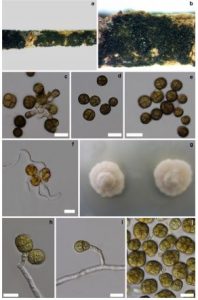Paraepicoccum amazonense Matsush., Matsush. Mycol. Mem. 7: 59 (1993). Index Fungorum number: IF360894
Saprobic on dead leaves or branches. Sexual morph: Undetermined. Asexual morph: Sporodochia dark, dense. Conidiophores up to 12 μm long, 4–5 μm diam., simple or branched, pale, olivaceous or golden brown, smooth, septate, with one or several apical conidiogenous loci. Conidiogenous cells monoblastic, pale brown. Conidia in vivo: 9.5–17.4 × 9.6–17.2 μm (x = 13 × 12.4 μm, n = 35), ellipsoidal, obclavate or subsphaerical, yellowish brown and 0–1 septate when young, becoming brown, muriform with several longitudinal or oblique septa when mature, finely guttulate; in vitro: 12.5–25 × 12–22.5 μm (x = 18.5 × 11.7 μm, n = 35), yellowish to golden brown.
Culture characteristics: Conidia germinating on PDAwithin 24 h and germ tubes produced from one or two cells. Colonies growing on PDA reaching 25 mm diam. After 21 days at 25 °C, circular to irregular, umbonate, dense, surface initially white, becoming dark olivaceous brown, after 2 weeks, reverse light golden brown, smooth surface with edge entire to curled.
Material examined: ITALY, Province of Ravenna [RA], Lido di Dante, on dead branches of Tamarix sp. (Tamaricaceae), 7 December 2014, Erio Camporesi IT 2287–3 (MFLU 16–0672, epitype designated here), living culture MFLUCC 15–0493, ICMP 21255; ibid. IT 2287–5 (MFLU 16–0673), living culture MFLUCC 15–0491
FIG Paraepicoccum amazonense (MFLU 16–0672, epitype) a, b Appearance of sporodochia on host surface c, h, i Conidiophores and developing conidia d, e, j Conidia f Germinating conidia g Colonies on PDA (h-j from MFLUCC 15–0493). Scale bars: c-f, j = 15 μm, h, i = 10 μm

